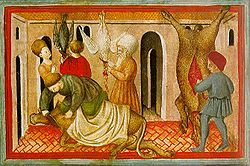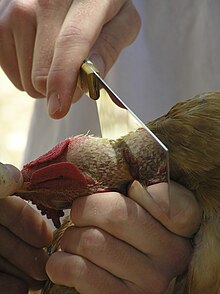ஹலால் என்பது இஸ்லாமிய முறைப்படி வெட்டப்படும் ஆட்டுக்கறி, கோழிக்கறி ஆகியவற்றை குறிக்கிறது. ஜட்கா என்பது இந்து முறைப்படி வெட்டப்படும் ஆட்டுக்கறி கோழிக்கறி ஆகியவற்றை குறிக்கிறது.
வெகுகாலமாக இந்தியாவில் ஜட்கா முறையிலேயே ஆடுகள் கோழிகள் வெட்டபப்ட்டு வந்தன. முனியாண்டி விலாஸ் போன்ற இந்து மிலிட்டரி உணவு கடைகளில் ஜட்கா முறையில் வெட்டப்பட்ட கோழிகள், ஆடுகளே சமைக்கப்பட்டு பரிமாறப்பட்டன. தற்போது பல இந்துக்களும் இஸ்லாமியர்களது கசாப்புக் கடைகளில் ஹலால் முறையில் வெட்டப்படும் கறிகளை வாங்கி வருகிறார்கள்.
அது மட்டுமல்ல தற்போது மெக்டொனால்ட் போன்ற அசைவ உணவு கடைகளும் ஹலால் முறையில் வெட்டப்பட்ட மிருகங்களையே பரிமாறி வருகின்றன. இது இந்து முறைப்படி தவறானதாகும்.
2007இல் சீக்கிய அமைப்புகள் மெக்டொனால்ட் போன்ற கடைகளில் சீக்கியர்கள் உணவு வாங்கக்கூடாது என்று அறிவுறுத்தியது. ஏனெனில் அந்த கடைகளில் ஹலால் முறையில் வெட்டப்பட்ட கறிகளையே வினியோகம் செய்கிறார்கள் என்று குற்றம் சாட்டியது.
இந்த செய்தியை ஹிந்துஸ்தான் டைம்ஸ், Jalandhar, October 7, 2003 இதழில் Jhatka vs halal: Sikh body raises meaty issue என்ற தலைப்பிட்ட பகுதியில் காணலாம்.
ஐரொப்பாவிலும் பல நாடுகளிலும் ஜட்கா என்றும் ஹலால் என்றும் பிரிக்கப்பட்ட உணவு வகைகள் விற்கப்படுகின்றன. அமெரிக்காவில் பல இந்துக்கள் ஜட்கா மாமிசத்தை வாங்குகிறார்கள்.
ஹலால் மூலம் கொல்லப்படும் மிருகங்கள் மிகுந்த கஷ்டத்தை அனுபவிப்பது ஹலால் முறையில் வெட்டப்படும் மிருகத்தை பார்த்தாலே தெரியும். மன தைரியமுள்ளவர்கள் இங்கே வீடியோவை பார்க்கலாம்.
(இதே போல இஸ்லாமிய பயங்கரவாதிகள் மனிதர்களையும் கழுத்தை அறுத்து கொல்லுவதையும் அந்த மனிதர்கள் துடிக்க துடிக்க சாவதையும் இஸ்லாமிய பயங்கரவாதிகள் வெளியிடும் வீடியோக்களில் நீங்கள் பார்த்திருக்கலாம்)
இந்தியாவின் பாரம்பரியத்தில் கொன்றால் பாவம் தின்றால் போச்சு என்று பொதுமக்கள் சொலவடையாக இருக்கிறது. ஆனால், எக்காரணத்தினாலும் ஒரு உயிரை துடிக்க துடிக்க கொல்வதும் அதன் கஷ்டத்தை அதிகரிப்பதும் தவறானது.ஒரு மிருகம் மெல்ல மெல்ல துடிக்க துடிக்க கொல்லப்படும்போதும் அதிலிருந்து ரத்தம் வெளியேறும் போதும் அதன் உடலின் செல்களில் விஷங்கள் (toxins) உருவாக்கப் படுகின்றன. அது உடலில் உள்ள ரத்தத்தில் கலந்து ஓரளவு வெளியேறினாலும், பல விஷங்கள் அதன் கறிப்பகுதிகளில் தங்குகின்றன. இவை நியூரோ டாக்ஸின் எனப்படும் மூளையையும் நரம்பையும் பாதிக்கும் விஷங்கள்.
இப்படிப்பட்ட பாதுகாப்பு செயல்பாடு பல மிருகங்களிடம் உள்ளது (Pharmacology of endogenous neurotoxins: a handbook By Andreas Moser). பல மிருகங்கள் தங்களை எதிரி மிருகங்கள் கொன்றுவிடக்கூடாது என்பதற்காக காயம்பட்ட பகுதியில் விஷத்தை சுரக்கின்றன. இதற்கு மூல காரணமாக இருப்பது உடலில் தோன்றும் வலி. ஆகையால், ஐரோப்பாவில் ஒரு மிருகத்தை Stun செய்து அதாவது அதன் மூளையை செயல்படாமல் ஆக்கிய பின்னால் அந்த மிருகங்கள் கொல்லப்படுகின்றன. இந்த மிருகங்கள் வலி உணர்வதில்லை. ஆனால், இவை ஹலால் உணவு அல்ல என்று முஸ்லீம்கள் உண்பதில்லை.
ஆனால், ஐரோப்பிய முறைப்படி Stun செய்யப்பட்ட மிருகங்களை கொன்று உண்பது ஜட்கா என்று கூறலாம்.
ஹலால் முறைப்படி வெட்டப்பட்ட மிருகத்தில் ரத்தம் இருப்பதில்லை. ரத்தம் வடிய விடப்பட்டு விடுகிறது. இந்த கறி சுவையற்றதாக ஆனாலும், மென்மையாக ஆகிவிடுவதால், இந்த கறியை பல இந்துக்கள் வாங்கி உண்கின்றனர். அதனால், அந்த துடிக்க துடிக்க கொல்லப்பட்ட மிருகத்தின் துயரத்துக்கு பொறுப்பாளியாகவும் ஆகி விடுகின்றனர்.
In 2003, an independent advisory group – the Farm Animal Welfare Council (FAWC) – concluded that the way halal and kosher meat is produced causes severe suffering to animals and should be banned immediately. FAWC argued that cattle required up to two minutes to bleed to death when such means are employed. The Chairperson of FAWC at the time, Judy MacArthur Clark, added, “this is a major incision into the animal and to say that it doesn’t suffer is quite ridiculous.”
இதே போல விலங்குகள் உரிமைகள் ஸ்தாபனம் போன்றவை மிருகங்களை கொல்வதற்கு பொதுவாக எதிர்ப்பு தெரிவித்தாலும், மிருகங்களை ஹலால் முறையில் கொல்வதற்கு கடும் எதிர்ப்பு தெரிவிக்கின்றன.
http://www.guardian.co.uk/uk/2003/may/15/religion.world
https://www.tamilhindu.com/2010/03/should-hindus-eat-halal-or-jhatka-meat/
BURNT Offering -Lord's way of Butchering at Holy of Holy- Total Unholy fraud un-Godly myths.
In Temple, the burnt offering was a twice-daily animal sacrifice offered on the altar in thet temple in Jerusalem that was completely consumed by fire. The skin of the animal, however, was not burnt but given to the priests respective of their priestly division. These skins are listed as one of the twenty-four priestly gifts in Tosefta Hallah.
http://www.jewishencyclopedia.com/articles/3847-burnt-offering
The ordinary translation in modern versions of the Hebrew "'olah" (
 ). This term does not mean literally "burnt offering," but "what is brought up" or presented to the Deity. The name is a translation of the Septuagint rendering, which is itself based upon the descriptive phrase often attached to "'olah" in the ritual prescriptions: "an offering made by fire unto the Lord" (Lev. i. 9 et seq.). A synonym is
). This term does not mean literally "burnt offering," but "what is brought up" or presented to the Deity. The name is a translation of the Septuagint rendering, which is itself based upon the descriptive phrase often attached to "'olah" in the ritual prescriptions: "an offering made by fire unto the Lord" (Lev. i. 9 et seq.). A synonym is , which defines the offering as complete; i.e., when it is placed upon the altar, to distinguish it from the other forms of animal sacrifice (see I Sam. vii. 9; compare Ps. li. 21). The burnt offering was the highest order of sacrifice in the Old Testament ritual. The bloodless offerings were made only in connection with it.
, which defines the offering as complete; i.e., when it is placed upon the altar, to distinguish it from the other forms of animal sacrifice (see I Sam. vii. 9; compare Ps. li. 21). The burnt offering was the highest order of sacrifice in the Old Testament ritual. The bloodless offerings were made only in connection with it.Shechita
 A 15th-century depiction of shechita andbedikah. It should be noted that the artist erroneously depicted knives with points at the tip, which are not acceptable for shechitah slaughter. | |
| Halakhic texts relating to this article | |
|---|---|
| Torah: | Deuteronomy 12:21,Deuteronomy 14:21,Numbers 11:22 |
| Babylonian Talmud: | Chullin |
| Mishneh Torah: | Sefer Kodashim, Hilchot shechita |
| Shulchan Aruch: | Yoreh De'ah 1:27 |
| Other rabbinic codes: | Sefer ha-Chinuchmitzvah 451 |
Hebrew Bible[edit]
In the Law of Moses[edit]
Multiple forms of offering[edit]
How to Properly Slaughter a Cow Under the Kosher Method Shechitah
Steps
- 1Select a knife (called a Chalif) of the appropriate size. The length of the blade is twice the width of the animal's neck.
- 2Thoroughly examine the animal prior to slaughter. If the animal is ill or injured, it is no longer considered Kosher. This has two purposes. First, it ensures the quality of the meat because an ill or injured animal should not be eaten anyway. Second, it provides a disincentive for Kosher farms to partake in the methods of other farms, because if the cow is hurt in any way, it cannot be slaughtered.
- 3Restrain the animal so that the slaughtering can be done correctly and painlessly. If the animal is injured during the restraining, it is no longer considered kosher.
- 4Inspect the blade of your knife. Make sure that there are absolutely no nicks or unevenness. The knife must be sharpened to such a sharp point that if the Shochet were to slice of his/her finger, he/she would feel no pain. [1]
- 5Cut the esophagus, trachea, carotid arteries, and jugular veins in one quick incision. The incision must not at all pull or tear. If done correctly, the animal will die within 2 seconds.
- 6Drain the blood of the animal completely. Eating blood is not Kosher, because the blood contains the soul of the animal.
- 7Examine essential organs of the animal. For mammals (cows, sheep, goats, etc.), make sure there are no defects. The lungs must be inflated to check for unwanted holes, and for signs of lung disease. If there are holes or signs of active lung disease, the cow is not considered kosher.
- 8Remove non-Kosher parts from the hind quarters of the animal. These include the blood vessels and the sciatic nerve. As with the lungs, this only applies to mammals.
- 9Remove all fat surrounding the vital organs. Internal fat, known in Hebrew as "cheilev," is not considered Kosher.
Tips
- Stunning is against the laws of Kashrut, although it may be more humane to stun the animal before cutting.
- By law, a Kosher slaughterer must be an honest, kind and upright man. A cruel person person cannot be a shochet.
- A person must be trained and certified by special rabbinic authorities to become a Shochet.
- There is no evidence that this method is more humane or less painful to the animal.
- Although some people say that the reason that non-kosher animals are forbidden to Jews is that many of them are either scavengers or have some other anatomical property that makes them more susceptible to carrying diseases and parasites, the simple fact is that the laws of Kashrut are a supra-rational set of commandments given to the Jewish people, and any rational or scientific justification is done after the fact.


















No comments:
Post a Comment